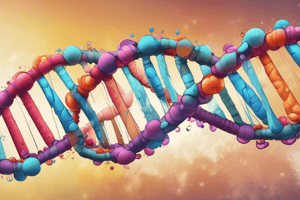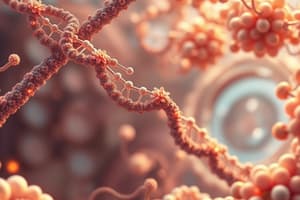Podcast
Questions and Answers
What is the main role of Single-Strand Binding proteins (SSB) during the DNA replication process?
What is the main role of Single-Strand Binding proteins (SSB) during the DNA replication process?
- To create replication bubbles.
- To prevent DNA strands from reannealing. (correct)
- To synthesize new DNA strands.
- To break hydrogen bonds between base pairs.
Which enzyme is primarily responsible for unwinding the DNA double helix during replication?
Which enzyme is primarily responsible for unwinding the DNA double helix during replication?
- Primase
- DNA-A protein
- Topoizomerase
- Helicase (correct)
What best describes the function of Topoizomerase during DNA replication?
What best describes the function of Topoizomerase during DNA replication?
- It synthesizes RNA primers.
- It synthesizes nucleotides for new DNA strands.
- It resolves supercoiling in DNA. (correct)
- It separates DNA strands at the point of origin.
What is the consequence of Quinolones on bacterial DNA replication?
What is the consequence of Quinolones on bacterial DNA replication?
What role does Primase play in the process of DNA replication?
What role does Primase play in the process of DNA replication?
Which statement correctly describes the activity of DNA polymerase?
Which statement correctly describes the activity of DNA polymerase?
How does Topoizomerase 2 differ from other types of Topoizomerases?
How does Topoizomerase 2 differ from other types of Topoizomerases?
What initiates the formation of the replication bubble in DNA replication?
What initiates the formation of the replication bubble in DNA replication?
What is the role of the ligase domain in Topoizomerase?
What is the role of the ligase domain in Topoizomerase?
Which statement about the leading strand is correct?
Which statement about the leading strand is correct?
What major role does DNA polymerase I play during DNA replication on the lagging strand?
What major role does DNA polymerase I play during DNA replication on the lagging strand?
What are Okazaki fragments?
What are Okazaki fragments?
Which enzyme is responsible for the synthesis of RNA primers?
Which enzyme is responsible for the synthesis of RNA primers?
What is the consequence of incorporating pseudonucleotides into the DNA strands?
What is the consequence of incorporating pseudonucleotides into the DNA strands?
How does the exonuclease domain of DNA polymerase I differ from that of DNA polymerase III?
How does the exonuclease domain of DNA polymerase I differ from that of DNA polymerase III?
What function does DNA ligase perform during DNA replication?
What function does DNA ligase perform during DNA replication?
In which direction does DNA polymerase proofread new DNA strands?
In which direction does DNA polymerase proofread new DNA strands?
Which term describes the complex involved in the synthesis of RNA primers?
Which term describes the complex involved in the synthesis of RNA primers?
The direction of synthesis for the lagging strand is away from what structure?
The direction of synthesis for the lagging strand is away from what structure?
Flashcards
Origin of Replication
Origin of Replication
The point on a DNA molecule where DNA replication begins; rich in adenine (A) and thymine (T) bases.
DNA-A Protein
DNA-A Protein
A protein that separates DNA strands at the origin of replication, initiating the replication process.
Replication Bubble
Replication Bubble
The region where DNA strands are separating and replication is taking place.
Single-Strand Binding Proteins (SSB Proteins)
Single-Strand Binding Proteins (SSB Proteins)
Signup and view all the flashcards
Helicaze
Helicaze
Signup and view all the flashcards
Supercoils
Supercoils
Signup and view all the flashcards
Topoizomerase
Topoizomerase
Signup and view all the flashcards
Primer
Primer
Signup and view all the flashcards
DNA Polymerase
DNA Polymerase
Signup and view all the flashcards
Replication Fork
Replication Fork
Signup and view all the flashcards
What does DNA Polymerase III do?
What does DNA Polymerase III do?
Signup and view all the flashcards
What does DNA Polymerase III's exonuclease domain do?
What does DNA Polymerase III's exonuclease domain do?
Signup and view all the flashcards
What is the leading strand?
What is the leading strand?
Signup and view all the flashcards
What is the lagging strand?
What is the lagging strand?
Signup and view all the flashcards
What is a primosome?
What is a primosome?
Signup and view all the flashcards
What are Okazaki fragments?
What are Okazaki fragments?
Signup and view all the flashcards
What does DNA Polymerase I do?
What does DNA Polymerase I do?
Signup and view all the flashcards
What does DNA Ligase do?
What does DNA Ligase do?
Signup and view all the flashcards
What are pseudonucleotides?
What are pseudonucleotides?
Signup and view all the flashcards
What are pseudo-nucleotides used for?
What are pseudo-nucleotides used for?
Signup and view all the flashcards
Study Notes
DNA Replication
- Replication begins by separating DNA strands at specific locations, rich in A-T base pairs, called origins or consensus areas. Bacterial DNA has one origin, while others have multiple.
- DNA-A protein initially separates DNA strands, creating a replication bubble.
- Single-strand binding proteins (SSB proteins) bind to separated DNA strands, preventing re-annealing and protecting them from damage.
- Helicase unwinds the DNA double helix, requiring a significant amount of energy. This creates supercoils in the DNA ahead of the replication fork.
- Topoisomerases resolve these supercoils, using a double-function enzymatic process.
- Topoisomerases have two domains: a nuclease domain (that cuts a DNA strand), and a ligase domain (that rejoins DNA strands). Several types exist with varying roles, for example in preventing tangling.
DNA Replication Enzymes
- Primase (DNA-dependent RNA polymerase) synthesizes RNA primers, providing a starting point for DNA polymerase.
- DNA polymerase is responsible for building new DNA strands by adding nucleotides to the 3' end of the growing chain.
- Polymerase reads the template DNA in the 3' to 5' direction but synthesizes new DNA strands in the 5' to 3' direction (so, the newly made strand is anti-parallel to the template strand), and proofreads its work.
- DNA polymerase has an exonuclease domain that removes incorrect nucleotides if a mistake is found.
- Leading strand synthesis occurs continuously, while lagging strand synthesis occurs in short fragments (Okazaki fragments) that are subsequently joined by DNA ligase.
- Primosomes are complexes of primase and other proteins that synthesize RNA primers on the lagging strand.
DNA Replication Errors and Inhibitors
- Pseudonucleotides (nucleoside analogs) lack a hydroxyl group on carbon 3' and can block further nucleotide addition
- Some drugs, like Didanosine, Vidarabine, Acyclovir, Cytarabine, and Zidovudine, are nucleoside analogs that become incorporated into the growing DNA chain, causing replication errors and inhibiting further replication.
- Some antibiotics, like Quinolones, interfere with Topoisomerases to prevent DNA replication.
- Cancer drugs, like Etoposide and Teniposide, target human topoisomerases.
- Vincristine and Vinblastine affect the mitotic spindle, inhibiting cell division.
- Paclitaxel and Docetaxel overstabilize the mitotic spindle.
DNA Polymerases
- There are different types of DNA polymerase enzymes in eukaryotes with specialized functions (X-pol, B-pol, Y-pol, 8-pol, and E-pol.) some similar to prokaryotes. Different DNA polymerases are specialized in different tasks - for example replicating leading and lagging strands, repair of DNA.
- Not all prokaryotic enzymes are the same as eukaryotic ones.
Studying That Suits You
Use AI to generate personalized quizzes and flashcards to suit your learning preferences.




